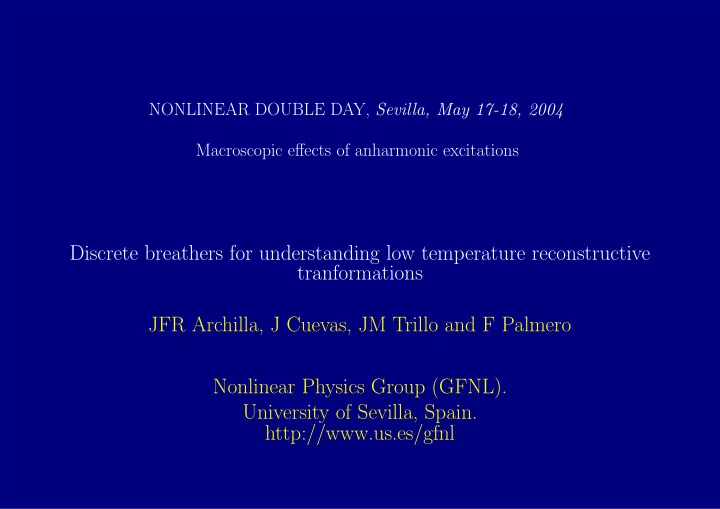

NONLINEAR DOUBLE DAY, Sevilla, May 17-18, 2004 Macroscopic effects of anharmonic excitations Discrete breathers for understanding low temperature reconstructive tranformations JFR Archilla, J Cuevas, JM Trillo and F Palmero Nonlinear Physics Group (GFNL). University of Sevilla, Spain. http://www.us.es/gfnl
Known facts LTRT can be described by: • Breaking of the Arrhenius law • An increase of the reaction speed • A diminution of the activation energy No explanation has been provided for LTRT Mackay and Aubry [Nonlinearity, 1994] suggested the breaking of Arrhenius law as a consequence of discrete breathers LTRT take place in the presence of a cation layer JFR Archilla, J Cuevas, JM Trillo and F Palmero, Nonlinear Double Day, Sevilla, 2004 2
Discrete breathers hypothesis Adventurous but worth trying Objectives: • Calculate 2D breathers in the cation layer for mica muscovite • Obtention of their energies • Are those energies enough to provide the increase of the reaction rate? Problems: • Choose a vibration mode • Construct the model • Obtain the parameter values JFR Archilla, J Cuevas, JM Trillo and F Palmero, Nonlinear Double Day, Sevilla, 2004 3
Mode: vibration of the K + perpendicular to the cation layer Geometry of the K + layer a 2 a 1 (n−1,n−1) (n−1,n) (n,n−1) (n,n) (n,n+1) (n+1,n−1) (n+1,n) JFR Archilla, J Cuevas, JM Trillo and F Palmero, Nonlinear Double Day, Sevilla, 2004 4
Mathematical model Hamiltonian � � 1 n ) + 1 � � u 2 n ′ ) 2 H = 2 m ˙ n + V ( u � ( u � 2 k n − u � � � n � n ′ ∈ NN Harmonic coupling • k=10 ± 1 N/m • D. R. Lide Ed., Handbook of Chemistry and Physics (CRC press 2003-2004) On-site potential V • Assignment of far infrared (30-230 cm − 1 ) bands through dichroic experiments, [Diaz et al, Clays and clay Miner. 71 , 701] • Linear frequency ω o =143cm − 1 • Nonlinearity of the potential unknown JFR Archilla, J Cuevas, JM Trillo and F Palmero, Nonlinear Double Day, Sevilla, 2004 5
Infrared spectrum at LADIR-CNRS Muscovite far infrared transmission spectrum 14000 12000 10000 Arb. units 8000 6000 4000 2000 0 200 250 300 350 400 450 500 cm −1 JFR Archilla, J Cuevas, JM Trillo and F Palmero, Nonlinear Double Day, Sevilla, 2004 6
On site potentials • Fitting of the on-site potentials to the observed IR bands • Method: Crystal structures and proton dynamics in potassium and cesium hy- drogen bistrifluoroacetate salts with strong symmetric hydrogen bonds A Cousson, JFR Archilla, J Tomkinson and F Fillaux, submitted physics/0404083 . 1200 1000 800 600 E (cm −1 ) 400 200 0 −200 −3 −2 −1 0 1 2 3 x (Amstrongs) JFR Archilla, J Cuevas, JM Trillo and F Palmero, Nonlinear Double Day, Sevilla, 2004 7
Choice of the on-site potential 1200 1000 800 600 E (cm −1 ) 400 200 0 −200 −3 −2 −1 0 1 2 3 x (Amstrongs) • V ( x ) = D (1 − exp( − b 2 x 2 )) + γx 6 • D=453cm − 1 , b 2 =36 ˚ A − 2 , γ =49884cm − 1 ˚ A − 6 • Consistent with the space available to the K + : 2 × 1.45˚ A JFR Archilla, J Cuevas, JM Trillo and F Palmero, Nonlinear Double Day, Sevilla, 2004 8
Breather profiles Energy density profiles for breathers Energy density (KJ/mol) Energy density (KJ/mol) 6 1 4 0.5 2 0 0 15 15 15 15 10 10 10 10 5 5 5 5 0 0 0 0 n y n y n x n x ν b = 164 . 15 cm − 1 E=22 . 82 KJ/mol ν b = 142 . 38 cm − 1 E=28 . 75 KJ/mol JFR Archilla, J Cuevas, JM Trillo and F Palmero, Nonlinear Double Day, Sevilla, 2004 9
Breather energies Energy with respect to the frequency 40 35 Energy (KJ/mol) 30 25 20 130 140 150 160 170 Breather frequency (cm −1 ) JFR Archilla, J Cuevas, JM Trillo and F Palmero, Nonlinear Double Day, Sevilla, 2004 10
Decrease of the activation energy Arrhenius law: k = A exp( − E a Reaction rate: RT ) Breather energy: ∆ E a k ′ = A exp( − E a − ∆ E a New reaction rate: ) RT Increase of the reaction rate k ′ k = exp(∆ E a RT ) Several hundreds of times faster JFR Archilla, J Cuevas, JM Trillo and F Palmero, Nonlinear Double Day, Sevilla, 2004 11
CONCLUSION Breathers in the K + layer have enough energy to provide the observed increase of the reaction speed PROBLEMS Quantum breathers? Is the band assignment correct? Mechanism for the transmission of energy? Discrete breathers for understanding reconstructive mineral processes at low tem- peratures , J Cuevas, JFR Archilla, MD Alba, M Naranjo and JM Trillo. Submitted, arXiv:nlin.PS/0404030 . JFR Archilla, J Cuevas, JM Trillo and F Palmero, Nonlinear Double Day, Sevilla, 2004 12
Recommend
More recommend